Onion
How to Cut an Onion (& Why Different Cuts Actually Matter)
How to slice, dice, roughly chop, finely chop, and mince your way to onion greatness.
0 seconds of 32 minutes, 26 secondsVolume 0%
Press shift question mark to access a list of keyboard shortcuts
Keyboard Shortcuts
Shortcuts Open/Close/ or ?
Play/PauseSPACE
Increase Volume↑
Decrease Volume↓
Seek Forward→
Seek Backward←
Captions On/Offc
Fullscreen/Exit Fullscreenf
Mute/Unmutem
Decrease Caption Size-
Increase Caption Size+ or =
Seek %0-9
Popular on Food52
Continue After Advertisement
35 Comments
IWearTheHat
November 25, 2020
I agree with some other viewers that commented; this video was more than just "cutting onions" and if that's all some got out of it then they truly missed the interaction between the master and the host or just didn't care, I guess. I watched Josh smile frequently throughout the video as he learned something each time Jacques held a knife and demonstrated, and it was interesting to see from Josh what is being taught today compared to how Jacques learned and practices. Heck, I learned how to peel a few other things in addition to things like thumb placement, etc. I enjoyed the video and the content very much; "heartwarming" is how I would describe seeing old school and new school working together and discussing.
jenzip
November 25, 2020
So what an HONOR to cook with Jacques. That was an excellent video and I immensely enjoyed it. However, I couldn't find a way to watch it with subtitles? I have a few deaf friends, and so now I prefer to watch things with subtitles, so, just a thought for you guys at Food52. Thanks!
jmohns
November 25, 2020
Master chef Jaques Pepin is the premier teacher. (Too bad the host didn't know that.)
holly M.
December 11, 2019
♥️ this video for so many reasons: educational, emotional, enjoyable. Thank you!
Zeelo
May 7, 2015
You+ABSOLUTELY+do+not+have+to+cut+an+onion+horizontally+as+shown+in+the+second+step!+An+onion+is+layered,+which+makes+this+step+redundant.
Elizabeth J.
March 28, 2015
re cutting onions without crying: keep your mouth shut and stand up straight. This tends to be good advice in many situations -- but it keeps your head, nose and eyes as far as possible from the onion. The candle idea makes sense - it burns off the gas before you inhale it, but gathering candle, holder and match would take me longer than cutting the onion. Interesting to hear all the methods people have found helpful if not perfect.
Stacey B.
October 27, 2014
The only "scientific" way to not have onion tears is to refrigerate the onions before cutting them (I think I heard this from Alton Brown).
tia
December 11, 2019
I use this trick and it works. That and a really sharp knife (mandolines are for suckers, in this case, they're never sharp enough). If I'm doing a LOT of onions, I'll sometimes set up a fan blowing across the work surface to blow the fumes away, which also works, but makes the whole house smell like onions.
Terrie A.
September 14, 2014
I light a candle while cutting onions. I've been doing this forever, and always assumed it was common knowledge. The fact that no one suggested it before me makes me wonder if it's just an old wives tale, and the mere power of suggestion has made it effective for me. Anyone else use this trick?
Michael G.
September 12, 2014
I keep the root and skin attached after I slice the onion through the top to the root. Fold the skin back, and it acts as a built-in handle.
According to The Help, holding a wooden match in your teeth prevents crying. I've not tried it.
According to The Help, holding a wooden match in your teeth prevents crying. I've not tried it.
chris
January 16, 2014
There are two methods I like for slicing onions without tears. One is to place as much distance as possible between the onion and my eyes by cutting the onion on a low surface, such as a dining table versus a counter top.
The second method is to place the onion to be cut on a cutting board. Use a cutting board with slots for draining water. Next run a small drizzle of water over the onion while cutting. This works best. Do not allow the water to run too fast or your cutting board may not drain fast enough and you will have a bit of a flood. Happy onion cutting !
The second method is to place the onion to be cut on a cutting board. Use a cutting board with slots for draining water. Next run a small drizzle of water over the onion while cutting. This works best. Do not allow the water to run too fast or your cutting board may not drain fast enough and you will have a bit of a flood. Happy onion cutting !
Rod
May 25, 2013
wowwwwwwwwwwwwww I am surprised you still have 10 fingers.... I hope you are not a qualified chef... if so who taught you that
Abby
May 22, 2013
I'd suggest a embedded video next time - much more useful, and elegant presentation. Unless your objective is to take up visual space, which this certainly does. Also, is your market people who have never cooked before? Cutting onions...really? Okay, if you say so, but I'd make put this under a tab called Kitchen Basics so you don't bore a more experienced audience. I like the concept of the website, but the content is lacking.
Jonathan H.
May 21, 2013
Best onion tear prevention?
First and easiest, use a sharp knife. It damages fewer cells, so less of the offending gas is produced, so there are less tears.
You should also ventilate the kitchen. You should do that anyway to handle the inevitable occasional smoke in there.
Also sweet onions produce far less of the offending gas, and they caramelize easily, if that's what you're looking for.
First and easiest, use a sharp knife. It damages fewer cells, so less of the offending gas is produced, so there are less tears.
You should also ventilate the kitchen. You should do that anyway to handle the inevitable occasional smoke in there.
Also sweet onions produce far less of the offending gas, and they caramelize easily, if that's what you're looking for.
Jonathan H.
May 21, 2013
None of these is the best and easiest approach. With one simple method (not gadget), you can have a mince, thin strips (julienne) or evenly cut dice. With ease.
As with these others, begin with peeling. Then trim away any green or brown at the top. Cut away most of the root, but leave the very bottom intact. It will make cutting easier.
Slice the onion in half from the top/green end to the bottom/root end.
Here's the cool part. Take one half and slice it lengthwise, radially.
Is that confusing? Make several slices from the outside towards the center.
To be more specific, lay your knife almost horizontally at just above your cutting board, and slice the onion from the round outer peel side towards the core. Try to make this slice, and every slice until you've gone all the way around, reach all the way to the center of the core.
So from here you would turn your knife a little bit towards vertical, and make another slice to the core.
With just a little practice, you will be able to slice one half or one quarter of an onion like this easily, depending on the size of your hands and the size of the onion.
At this point you have thick or thin slices, depending on how you cut. You tried to make them even, how'd you do? It's up to you and what you want from this onion. Do you want big slices to cook with liver? Or do you want a fine mince for topping a fish taco (use purple for this)?
Anyway, onions are great, and if you now just cut crossways, your slices become a dice.
This method is really easy. People will be impressed with your knife skills.
You can apply a very similar method to carrots, celery, potatoes, anything.
As with these others, begin with peeling. Then trim away any green or brown at the top. Cut away most of the root, but leave the very bottom intact. It will make cutting easier.
Slice the onion in half from the top/green end to the bottom/root end.
Here's the cool part. Take one half and slice it lengthwise, radially.
Is that confusing? Make several slices from the outside towards the center.
To be more specific, lay your knife almost horizontally at just above your cutting board, and slice the onion from the round outer peel side towards the core. Try to make this slice, and every slice until you've gone all the way around, reach all the way to the center of the core.
So from here you would turn your knife a little bit towards vertical, and make another slice to the core.
With just a little practice, you will be able to slice one half or one quarter of an onion like this easily, depending on the size of your hands and the size of the onion.
At this point you have thick or thin slices, depending on how you cut. You tried to make them even, how'd you do? It's up to you and what you want from this onion. Do you want big slices to cook with liver? Or do you want a fine mince for topping a fish taco (use purple for this)?
Anyway, onions are great, and if you now just cut crossways, your slices become a dice.
This method is really easy. People will be impressed with your knife skills.
You can apply a very similar method to carrots, celery, potatoes, anything.
Peter J.
May 19, 2013
I have found keeping onions in the fridge reduces the amount of gaseous compounds released, tears are a thing of the past if you get the job done fast !
Henry B.
May 19, 2013
Your finger postioning is dangerous - you appear to realise this. Curl your fingertips in under the length of the finger, and use the broad width of that santoku to butt up against the shortened fingers .... raise and lower the santoku against the 'fence' of the fingers. The way I see your fingers here, it's only a matter of time until one gets nicked, or worse. As for tears ..... just keep working, they don't hurt and they don't last long.
max H.
May 18, 2013
No joke, I wear my scuba mask. , yes with the snorkel but I don't use it. Looks ridiculous and works.
judy H.
April 24, 2013
When I cut up onion I strike a match blow it out and put it between your teeth. I buy the long kitchen matches.
BlueLineGal
September 25, 2012
Best anti-onion-crying technique? I've found that breathing through the mouth (and not through the nose) while chopping prevents watery eyes. Perhaps because you inhale more of the onion's gases through the mouth (versus nose) before they reach your eyes or inhaling through the nose draws the gas closer to the eyes, thus creating more irritation.
Pegeen
July 11, 2012
Goggles, for sure (or an old pair of sunglasses). I've tried everything else except contact lenses.
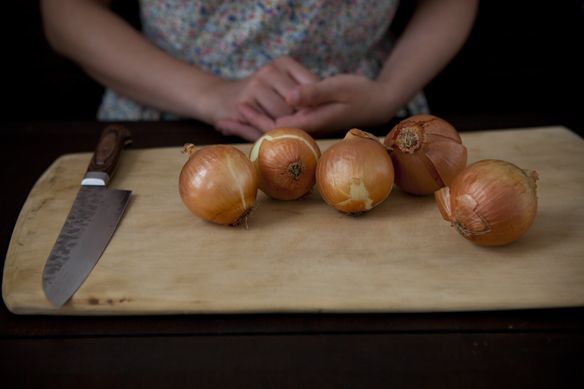
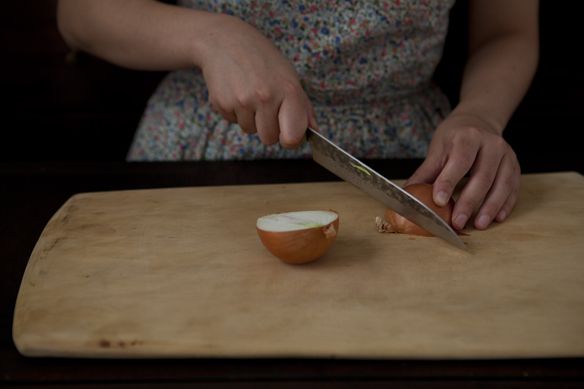
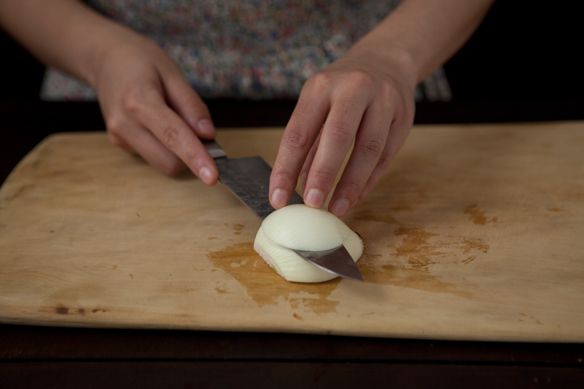
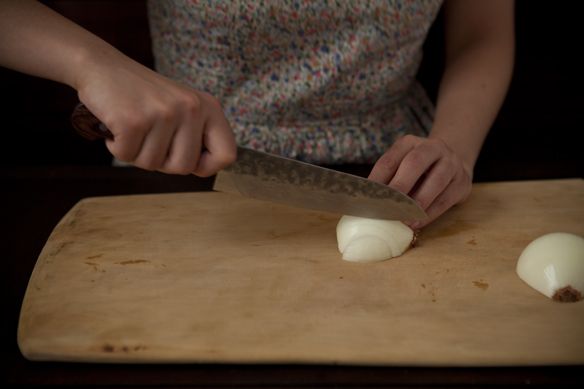
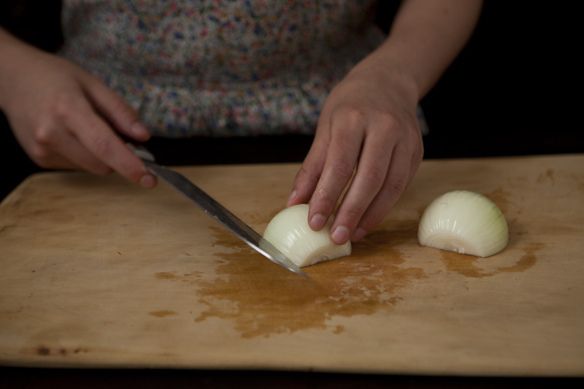
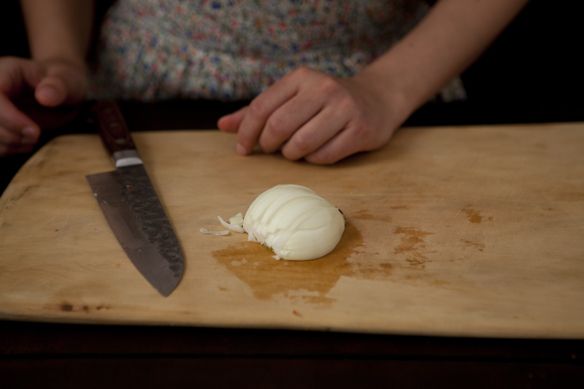
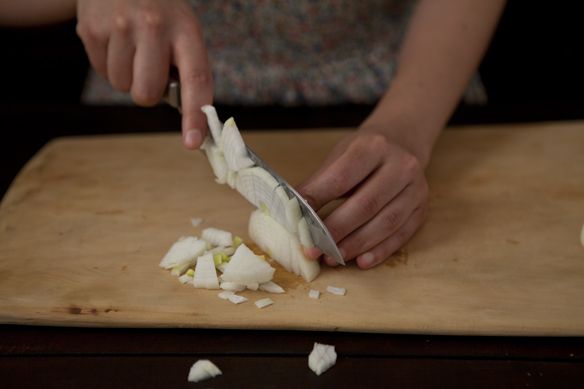
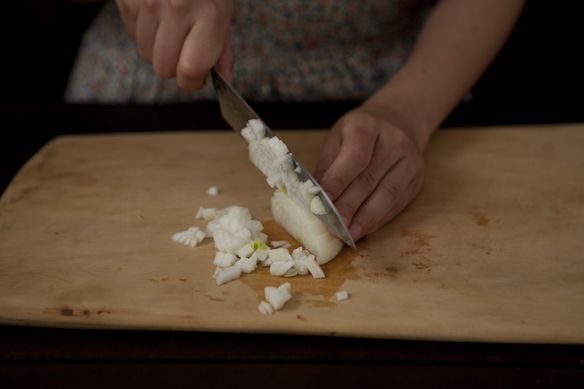
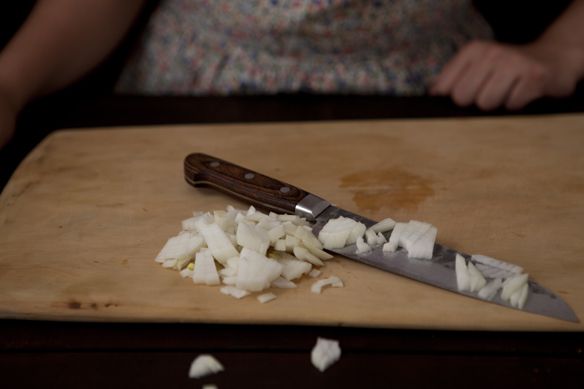
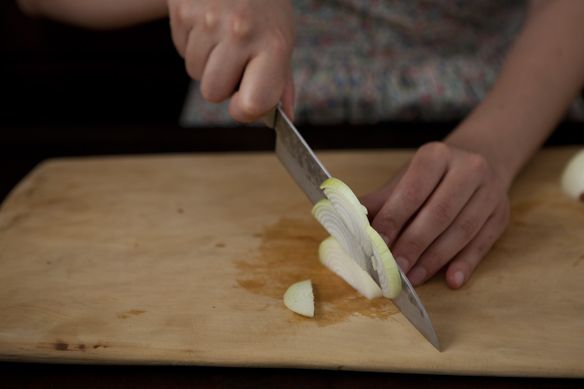

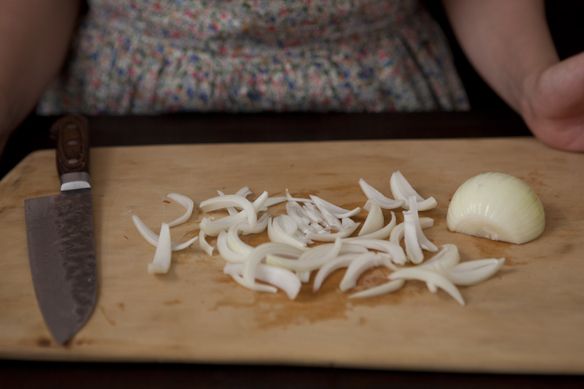
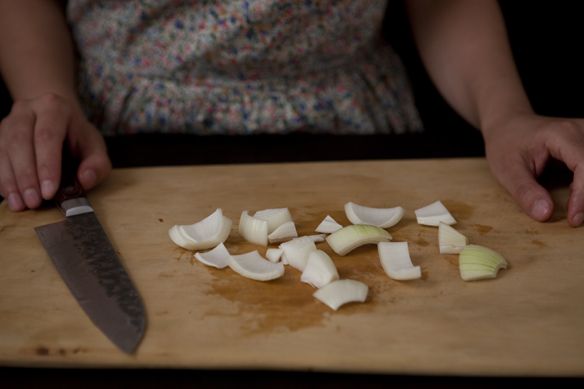

See what other Food52 readers are saying.